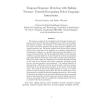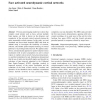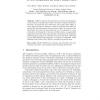262 search results - page 4 / 53 » Spatio-temporal join selectivity |
CONNECTION
2006
13 years 7 months ago
2006
We present an approach for recognition and clustering of spatio temporal patterns based on networks of spiking neurons with active dendrites and dynamic synapses. We introduce a n...
MBEC
2011
12 years 10 months ago
2011
Previous neuroimaging studies have shown that complex visual stimuli, such as faces, activate multiple brain regions, yet little is known on the dynamics and complexity of the acti...
IIS
2004
13 years 9 months ago
2004
Estimating the result size of a join is an important query optimization problem as it determines the choice of a good query evaluation strategy. Yet, there are few efficient techni...
IS
2006
13 years 7 months ago
2006
Given two sets S1, S2 of moving objects, a future timestamp tq, and a distance threshold d, a spatio-temporal join retrieves all pairs of objects that are within distance d at tq....
CORR
2010
Springer
13 years 7 months ago
2010
Springer
Different types of data skewness can result in load imbalance in the context of parallel joins under the shared nothing architecture. We study one important type of skewness, join ...



